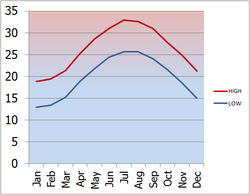Hsinchu County 新竹縣 [I] | |
|---|---|
 | |
 | |
| Coordinates: 24°50′0″N121°0′53″E / 24.83333°N 121.01472°E | |
| Country | |
| Province | |
| Seat | Zhubei City |
| Townships/cities | |
| Government | |
| • Body | |
| • Magistrate | Yang Wen-ke (KMT) |
| Area | |
• Total | 1,427.59 km2 (551.20 sq mi) |
| • Rank | 12 of 22 |
| Population (October 2023) | |
• Total | 588,535 |
| • Rank | 10 of 22 |
| • Density | 412.258/km2 (1,067.74/sq mi) |
| Time zone | UTC+8 (National Standard Time) |
| ISO 3166 code | TW-HSQ |
| Website | www |
| Symbols | |
| Bird | Muller's barbet ( Megalaima oorti ) |
| Flower | Camellia |
| Tree | Broad-leaved podocarpus ( Nageia nagi ) |
| Hsinchu County | |||||||||||||||||||||||||||||||
|---|---|---|---|---|---|---|---|---|---|---|---|---|---|---|---|---|---|---|---|---|---|---|---|---|---|---|---|---|---|---|---|
| Traditional Chinese | 新竹 縣 | ||||||||||||||||||||||||||||||
| |||||||||||||||||||||||||||||||
Hsinchu [I] is a county in north-western Taiwan. The population of the county is mainly Hakka;with a Taiwanese aboriginal minority in the southeastern part of the county. Zhubei is the county seat,where the government office and county office is located. A portion of the Hsinchu Science Park is located in Hsinchu County.
Contents
- History
- Early history
- Qing dynasty
- Japanese rule
- Republic of China
- Geography
- Climate
- Administration
- Demographics
- Economy
- High tech industry
- Education
- Energy
- Power generations
- Water supply
- Tourist attractions
- Sports
- Transportation
- Rail
- Notable people
- International relations
- Sister cities
- Notes
- Words in native languages
- References










